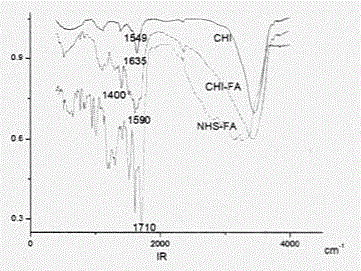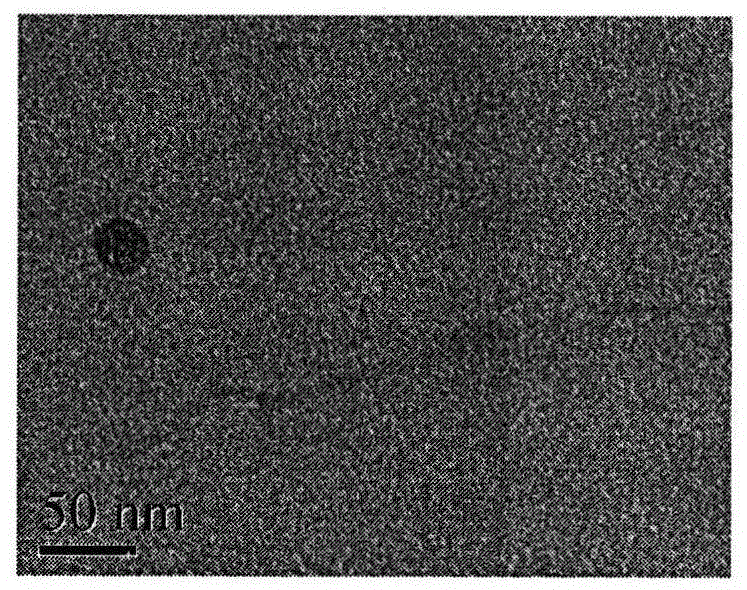Preparation of a multi-walled carbon nanotube composite material modified by folic acid and chitosan
A technology of multi-walled carbon nanotubes and chitosan, which can be used in medical preparations, drug combinations, and pharmaceutical formulations with non-active ingredients, can solve problems such as solubility and biocompatibility limitations, and achieve good biodegradability. and biocompatibility, uniform appearance, no toxic and side effects
- Summary
- Abstract
- Description
- Claims
- Application Information
AI Technical Summary
Problems solved by technology
Method used
Image
Examples
Embodiment 1
[0029] Example 1: Acidification of multi-walled carbon nanotubes.
[0030] Add multi-walled carbon nanotubes (100 mg) and a certain amount of nitric acid (50 ml) into a 100 ml three-necked bottle, and ultrasonicate for 30 min. After the ultrasonication is completed, reflux at 120° C. for 10 h, stop the reaction, and stand overnight. After separating the nitric acid in the upper layer, dilute with distilled water and let stand again. Repeat the above operation, separate the upper aqueous solution, and then add distilled water to the remaining reaction solution for dilution. Centrifuge the reaction solution at 7000r / min for 3min, add water to dilute and centrifuge, remove the supernatant, repeat 2-3 times until the upper liquid is ink-colored. The supernatant was separated, and the obtained solid was dried overnight under an infrared lamp to obtain acidified carbon nanotubes.
Embodiment 2
[0031] Example 2: Characterization of acidified carbon nanotubes.
[0032] Infrared data of acidified carbon nanotubes show that 1640cm -1 The absorption peak produced by the stretching vibration of the carbon-oxygen double bond is at 3400cm -1 is the absorption peak produced by the oxygen-hydrogen stretching vibration. The above conclusions indicate that the nanotubes have been modified with acidic groups. (see figure 1 )
[0033] Measuring the zeta potential of multi-walled carbon nanotubes before and after acidification shows that the zeta potential value of carbon nanotubes before acidification is 32.4mv, and the potential of carbon nanotubes after acidification drops to -28.2mv, indicating that the surface of carbon nanotubes has been connected with negatively charged groups. That is, the carboxyl group has been successfully attached.
Embodiment 3
[0034] Embodiment 3: Preparation of folic acid activated ester.
[0035] Add folic acid (882mg) and anhydrous dimethyl sulfoxide (20ml) in a 50ml three-necked bottle, and add condensing agent dicyclohexylcarbodiimide (DCC), N-hydroxysuccinimide (NHS) and A certain amount of triethylamine was reacted overnight at 45°C in the dark under the protection of nitrogen. Stop the reaction, let the reaction solution stand still, remove the white by-product dicyclohexyl urea by suction filtration, drop the mother liquor into anhydrous ether solution containing 30% acetone, precipitate a yellow solid, filter, and dry the obtained solid in vacuum to obtain folic acid activated ester .
PUM
| Property | Measurement | Unit |
|---|---|---|
| electric potential / voltage | aaaaa | aaaaa |
Abstract
Description
Claims
Application Information
 Login to View More
Login to View More - R&D
- Intellectual Property
- Life Sciences
- Materials
- Tech Scout
- Unparalleled Data Quality
- Higher Quality Content
- 60% Fewer Hallucinations
Browse by: Latest US Patents, China's latest patents, Technical Efficacy Thesaurus, Application Domain, Technology Topic, Popular Technical Reports.
© 2025 PatSnap. All rights reserved.Legal|Privacy policy|Modern Slavery Act Transparency Statement|Sitemap|About US| Contact US: help@patsnap.com



